Streaming and Podcasting with a Guy from Queens | Telos Alliance
By The Telos Alliance Team on Sep 30, 2015 5:00:00 AM
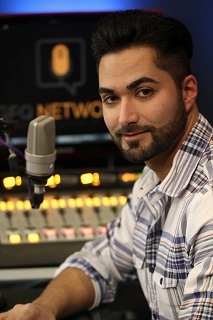 Streaming and Podcasting with a Guy from Queens
Streaming and Podcasting with a Guy from Queens
Andrew Zarian is the founder and President of GFQ Networks, a tech-savvy Internet broadcaster located in Queens, New York. Currently the hosts of a dozen different streaming video shows and a couple more podcasts, GFQ is one of the up-and-comers in the Internet streaming world – and also a Telos Alliance client. We sat down with Andrew to get the scoop on how he started, and where he thinks Webcasting is headed.
CN: Tell me about yourself. Where’d you grow up? What did you think you would be doing for a living when you were a little kid?
AZ: I was born and raised in Queens, New York. I never had an idea that I’d be doing what I’m doing now, but in hindsight you can look back and see a lot of things that kind of point at it. If I’d had someone to push me, or I’d had someone around me that was in radio or in broadcasting, I probably would have gone down the same path, but I grew up in a blue-collar family; my father worked 90 hours a week, and my whole life I was supposed to go to school and be a lawyer, be a lawyer, be a lawyer.
But when I was 18 or 19, I got a really good promotion at my job, and my father sat me down and gave me the best advice ever: he said “You gotta make money in life. I don’t really care what you do – you could become a cop, you could become a lawyer, you could become a doctor. As long as you’re not working as much as I’m working, you’re doing great.”
It was a good piece of advice because I always looked at my father as a really hard-working guy; he worked insane hours, and I took a very different path.
CN: So what turned you on to broadcasting?
AZ: I was always a huge fan of radio. Growing up in New York in the ‘90s, if you were in a car somewhere, you listened to Howard Stern. So I grew up listening to Howard, or Don Imus. And my mother was a huge Don Imus and Howard Stern fan, so I really got into listening to radio at a young age, and it stuck with me.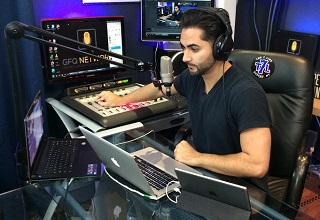
My grandfather used to listen to a lot of talk radio; that’s how he picked up the language and learned English. My grandfather used to listen to Bob Grant, and I always found him interesting. So if I think back, it was Bob Grant, Howard Stern and Don Imus.
CN: When did you decide to be a broadcaster yourself? When did that light-bulb go on?
AZ: 2007. I was doing IT at the time, and they were totally downsizing, the economy was tanking, I had just gotten married, just bought a house and just bought a new car, so… great time to get laid off! I mean, all the stars aligned, right there.
One of my buddies was a stand-up comic in New York, and he had this idea to do a podcast. “We should do this thing called ‘The Guys From Queens’ and it’ll just be me and you, and we’ll just talk, and it’ll be the place for me to test out material, and you can just vent on the air. I know you’re stressed, you’re looking for a job; I think we should do this, it’s good for both of us.”
I said “Alright, let’s try it,” because I like to talk… and if anybody’s gonna listen I’m willing to talk, so we started doing the show. We were doing it in my kitchen.
I had some idea of how to do it, but I didn’t want to spend the money at the time. So he would sit in my kitchen and Skype me, and I would sit in my office. We were in the same house, Skyping each other and recording the audio on my end. So that was my first podcast.
CN: Oh, that’s beautiful!
AZ: And then we had the idea of doing it live. We couldn’t figure out how to do the show live, [plus] it was going to cost a lot to do it. You had to get a server, create an ICECast or Shoutcast server, pay for hosting. This was only seven years ago!
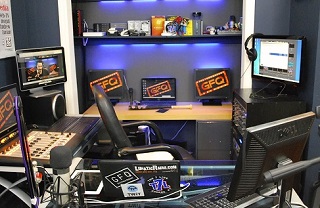 So my partner found this website called Stickam. You could set up a Webcam and just stream your audio via Webcam. So we set up a camera in my office; my friend is sitting next to me and I’m sitting there – two mics – and we started talking and all of a sudden, I saw the viewer numbers shoot up! I mean, we had, like, five people listening… probably his girlfriend, my wife, my mother, you know – friends and family. And all of a sudden, the numbers shot up to, like, 5,000!
So my partner found this website called Stickam. You could set up a Webcam and just stream your audio via Webcam. So we set up a camera in my office; my friend is sitting next to me and I’m sitting there – two mics – and we started talking and all of a sudden, I saw the viewer numbers shoot up! I mean, we had, like, five people listening… probably his girlfriend, my wife, my mother, you know – friends and family. And all of a sudden, the numbers shot up to, like, 5,000!
I got a message, while we were on break, from the Program Director in charge of creating new content for that website. Her name was Heather Sangria; that was the only time I ever spoke to her, and she introduced herself and said “I’m moving to Queens next week and I really like you guys. I put you in the front-page rotation.”
And that was all I needed. I started off from there. When we started doing this, I had no idea that I’d be doing it seven years later. We were just looking to kill some time because we were both bored and discouraged with our careers.
CN: You had a tool there that over-the-air broadcasters don’t have, which is immediate feedback regarding how many people are tuned in and paying attention.
AZ: Yeah. That part can be both a positive and negative. I like the engagement; I like to be told how I can improve. For others, if they don’t see what they were expecting, it could be discouraging and they may give up.
CN: So, was Stickam’s demise what prompted you to start your own network?
AZ: Well, while we were there, the new Front Page Director that took over really liked us, so we became a partner with them. They actually were paying us to create content for them. And that was the point that we decided “Maybe we should grow this and make it a  network.”
network.”
So we made it the Guys From Queens Network and had all different types of shows. Then, we realized that we were growing beyond just New York, and we became GFQ.
At the same time we were doing this on Stickam, we were also on Ustream, Justin.TV, and all these different CDNs [“Content Distribution Networks” – Ed.], all these different streaming services, rather than just committing to one. At the time, there was a lot of discoverability on these sites. It was new, it was fresh, a lot of people were trying to get into online broadcasting, and a lot of people were trying to discover new content. It was a great time for us, and our core audience is still from that group.
CN: Let’s talk more about “discoverability.” There are a lot more streams now than there were when you first began. This doesn’t impact established streamers, but could make it harder for startups. Any thoughts?
AZ: I think it’s a great thing for everybody that there are more people doing this, because it brings in more people who might not have found you traditionally.
The bad thing is that a lot of these sites don’t really care about discoverability, because the way that they’re generating revenue is through subscription services for things other than, say ‘Andrew’ podcasting, or ‘Andrew’ having a live stream. They’re making their money from corporate events and enterprise accounts. They’ve kind of shifted the way they generate revenue, so discoverability is virtually non-existent on 90% of the sites that used to really drive content on the front page. Which is a little sad, because without that, how do you find new content and get people to come back to your website?
CN: How do you get around that obstacle?
AZ: Luckily for us, we have a great relationship with iTunes, so whenever we create a new show or have a special they’ll always feature us. Same thing goes for a lot of these podcasting apps. But that’s due to the relationship I’ve built over the last seven years with them.
For folks just starting out, it’s social media and knowing how to use it to find the audience who’s interested in what you’re doing. It’s not really about numbers on social media, it’s more about people who are really interested in what you’re doing or promoting.
We’ve come up with a good way to find new followers, but making your content topical is key. This Week In Radio Tech, for example, has their own Twitter account. What The Tech has their own Twitter account. We have a pro wrestling show, Mat Men, that’s had great success with their Twitter campaign.
CN: So the use of social media works with the targeted content to amplify your reach.
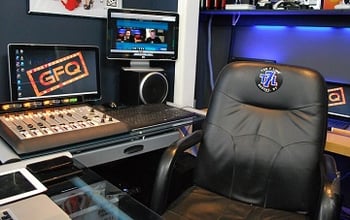 AZ: Yes. It just comes down to talking to people who are talking about the same thing you’re discussing on your show and turning them into an audience.
AZ: Yes. It just comes down to talking to people who are talking about the same thing you’re discussing on your show and turning them into an audience.
CN: You’ve mentioned a couple of shows there that our readers will definitely be familiar with – TWiRT and What The Tech. But you’ve got, like, a dozen shows now, right?
AZ: Yes, we have 12 shows right now. At the end of September we add new shows; we add about four shows every year. If it works we keep it, if it doesn’t work, we try something new. We’re always trying to come up with new ideas and add something new every year.
CN: Let’s talk about a topic close to our hearts – gear! What was your first studio setup?
AZ: Well, it was two USB microphones at first, in two separate rooms! But within a couple months we moved up to higher-end stuff. We got a Mackie board and dbx mic processors, we set up 4 microphones in the studio. So we jumped in head-first early on, and it lasted us a couple of years. Then we went to the Telos gear.
CN: You’ve got quite a few pieces of Telos Alliance equipment, right? What all do you have?
AZ: We’ve got the Radius console for mixing audio, with a QOR.32 mixing engine, we have an Omnia ONE Multicast for general audio processing, we have the Z/IPStream R/1 for our audio-only feed, and we’re using an Axia Analog node to feed our Skype mix-minus.
CN: Thank you!
AZ: Oh, it’s night-and-day between real broadcast gear and the pro-audio stuff. But you know what the negative is?
CN: What?
AZ: I had to go to Los Angeles to build a studio for somebody and they were using pro-sumer stuff. All I could think of was “Why can’t I just connect Livewire and call it a day?!”
(Laughs)
Livewire has simplified my setup so much that I have to think a couple of extra minutes about just setting 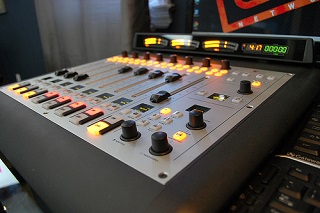 up another kind of studio now, because it’s made my life so much easier.
up another kind of studio now, because it’s made my life so much easier.
CN: I imagine that things like automatic mix-minus were a huge step forward.
AZ: Yeah! At this place in LA, I was sitting there and trying to work out a mix-minus in my head using Aux sends, and I was just cursing at this thing; if I’d had an Axia board it would have just popped and I would have been done.
And not just mix-minus – how about ground loops? It drove me nuts. Even with a ground-loop isolator I couldn’t fix it; we finally got it but I had to extend my trip a couple of days because this buzz would not leave!
CN: Tell us about building your own studio. How was it?
AZ: Kirk (Harnack) came down and assisted with the build. He was very helpful; I learned so much. I was blown away by the difference in the quality of the gear alone, and then the quality of the audio – how much it improved from going to professional studio equipment, rather than piecing it together using consumer-grade stuff.
The simplest thing that made a difference, believe it or not, was the buttons.
CN: Buttons? You’re going to have to explain that one.
AZ: It sounds really mundane and unimportant, and people who’ve never used broadcast gear won’t understand. But the quality of the fader and the on/off switch for the mic made a huge difference.
It’s the feel of things; it’s a very different feel. The saving of that half-a-second that it takes you to fiddle around and find the right control on a complicated Behringer or Mackie board with a thousand little buttons actually affects the sound of the program; real pro equipment is well worth it in the long run.
CN: If someone new to the business asked “How do I set up something like you have,” what would you tell them about putting a studio together?
AZ: Read the manual!!!
(Laughs)
If you’re coming from the consumer world into broadcast gear like Telos or Axia, it’s very different and you 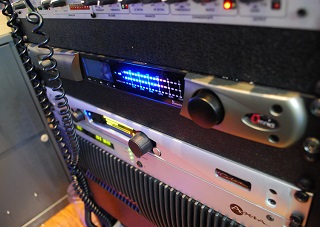 have to re-think things. And most likely, you’re doing things a little wrong!
have to re-think things. And most likely, you’re doing things a little wrong!
You have to pay attention to the details and the small things; like converting consumer (unbalanced) line-level audio to pro-level audio. You should either talk to someone before you do it, or hire someone who knows and learn from them.
And then there’s Livewire audio. It really simplifies setup and changes the way you think about audio.
CN: What’s an example of how this experience changed the way you think about audio?
AZ: Recently, I went into somebody’s studio and they’d put in a competitor’s equipment. I was helping them tear stuff apart, and they had a 150-foot RCA (cable) run going through two amplifiers! I asked, “Why? Why are you doing that?”
And they said “Well, it works.”
And I said, “Yeah, but not really!”
(Laughs)
It doesn’t really work; it sounds like crap! There’s noise, there’s ground loops happening, it’s not really working… They think it’s working. They’re going through dozens of connectors, through amplifiers, converting from RCA to 1/4”, then down to 1/8”, back to 1/4” – it’s crazy!
In the Internet broadcasting world, podcasters tend to think “It’s pieced together and if it works, it works, and that’s what we’re doing right now.”
I was doing the same thing, but I learned better. Instead of “If it works, it works,” the right mentality to have is “Let me learn about this and do it the right way, before I call it a day.”
CN: So the advice you’d give is to spend a little time and search out the info before you go hog-wild.
AZ: Yeah, exactly.
CN: Let’s switch topics. A lot of people are saying that Internet streaming is where broadcasting is going. What’s your opinion about that?
AZ: I think we’ll see more guys from broadcast coming to the Internet than the other way around, which is interesting to me. It used to be the opposite way, where people would be scouted out and brought over to regular radio. Big-name guys like Tom Leykis have totally dived in and are doing everything on the Internet now; he’s selling ads on his own.
I think you’ll see a lot more of the big names come over. Howard (Stern) has his contract ending in a couple of months; I would not be surprised if he goes to a podcast format.
It’s easy, and it’s not; because now you’ve got to have a sales team, and a marketing team. Normally the station would be doing this.
CN: Why do you think that will happen?
AZ: I just had this discussion with Chris Tobin the other night. It could be that radio doesn’t look at the Internet as a “real” source for talent – or it could just be that they don’t want to take the risk. Why would 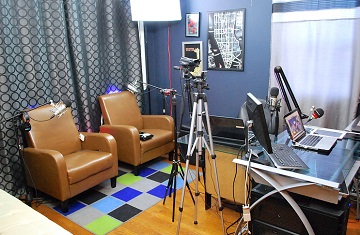 they take a risk on some guy from the Internet?
they take a risk on some guy from the Internet?
Internet broadcasts also don’t require the discipline of an on-air broadcaster. I can do a three-hour show, but you tell me to do a talkup to the break and I’m going to be going “homina, homina” for a couple of minutes. I’m not trained in that sense. I just flip a switch, come on camera and say “OK, we’re going to start now.”
CN: Would you say that what you’re doing is more akin to a long-form public radio program than commercial radio?
AZ: Yeah. We still have spots; I do two or three live reads for an hour-and-a-half show, and that’s easy and fun, because you make it your own and make it interesting for the fans. The advertisers generally appreciate what you do when you take that liberty.
CN: In the traditional broadcasting world, Leo Laporte is one of the masters of taking a spot and turning it into information.
AZ: Yeah. And listen, people aren’t paying for a five-minute spot, these advertisers; they’re paying for two to three minutes, and Leo’s doing a 10-minute spot on Audible, well – they’re getting their money’s worth right there! And the audience enjoys it; they’re into it. Nobody’s complaining, saying “Oh, God, Leo, why are you talking about this for 10 minutes?” It’s the exact same technique, just done a little differently, and it goes a long way.
CN: Let’s say there’s someone reading this interview who’s where you were 10 years back. They’re asking “How do I get into this? Where do I start?” What advice would you give?
AZ: I’m going to give myself a little plug; I have a website called IAIB, the International Association of Internet Broadcasters. We have a forum where people can ask questions and get information. It’s a free membership. I don’t charge for it because when I started, there were very few resources for this kind of information. And on the few pages that existed, most were giving improper information because the folks writing the pages weren’t from the industry. I would have saved so much time, effort and headaches if there had been a resource like this.
We have a lot of experts on there, who really understand audio and video. Just go there and start reading. Even if you don’t ask any questions of your own, start looking at the threads and seeing what people are saying.
Also, I suggest starting small. Don’t go crazy with it. Just go with an (Audio-Technica) ATR2100 USB mic, a good set of headphones so you can hear what you’re saying, and start recording.
CN: I knew about the IAIB, but I didn’t know it was you!
AZ: Yeah, we put it up a couple of years ago, and we get thousands of hits every day. People are still searching and looking for information. In fact, you wouldn’t believe how many messages I get from people on the site who tell me “I just got a Radius and I absolutely love it!” Or, “I got a Z/IP ONE to replace Skype – oh my God!” These are people not familiar with the Telos brand because they’re not from broadcasting; these are Internet broadcasters who ar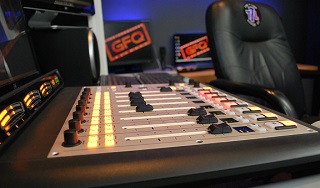 e trying to take their equipment to the next level.
e trying to take their equipment to the next level.
CN: Anything else?
AZ: I really love the Telos Alliance gear; it’s made my life much easier, to the point that running my show is a thoughtless process for me now. I go in and hit a button and I’m done; I don’t have to play around with everything.
Plus now I can just tell everybody “No, the problem’s not on my end, it’s you!” (Laughs)
If anybody is ready to take their Internet broadcast to the next level, I highly recommend Telos, Omnia and Axia gear. Compared to a lot of other brands out there, the difference is night and day.
Telos Alliance has led the audio industry’s innovation in Broadcast Audio, Digital Mixing & Mastering, Audio Processors & Compression, Broadcast Mixing Consoles, Audio Interfaces, AoIP & VoIP for over three decades. The Telos Alliance family of products include Telos® Systems, Omnia® Audio, Axia® Audio, Linear Acoustic®, 25-Seven® Systems, Minnetonka™ Audio and Jünger Audio. Covering all ranges of Audio Applications for Radio & Television from Telos Infinity IP Intercom Systems, Jünger Audio AIXpressor Audio Processor, Omnia 11 Radio Processors, Axia Networked Quasar Broadcast Mixing Consoles and Linear Acoustic AMS Audio Quality Loudness Monitoring and 25-Seven TVC-15 Watermark Analyzer & Monitor. Telos Alliance offers audio solutions for any and every Radio, Television, Live Events, Podcast & Live Streaming Studio With Telos Alliance “Broadcast Without Limits.”
Recent Posts
Subscribe
If you love broadcast audio, you'll love Telos Alliance's newsletter. Get it delivered to your inbox by subscribing below!